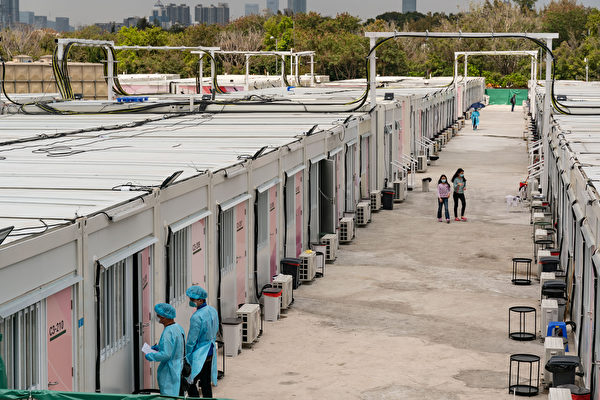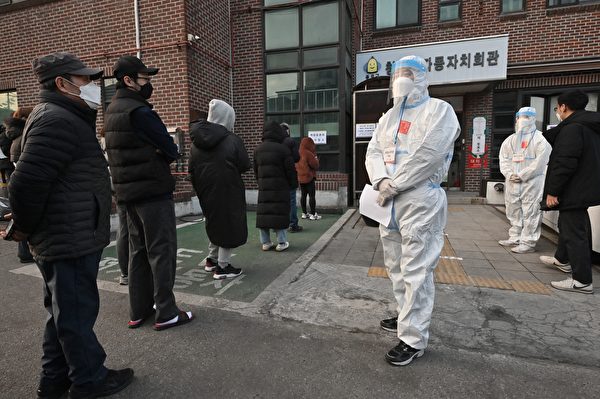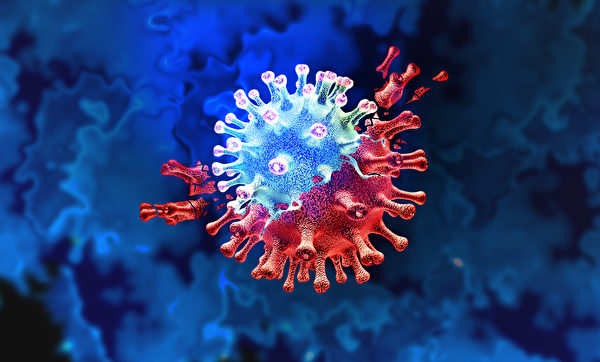[The Epoch Times, March 13, 2022](The Epoch Times reporter Daphra comprehensive report) According to statistics from Johns Hopkins University, as of 2:20 a.m. EST on Sunday (March 13), the world‘s The total number of cases of CCP virus (Wuhan pneumonia, coronavirus, COVID-19) exceeds 456 million (456,820,710) and the death toll exceeds 6.04 million (6,040,683).
The following are the statistics of the number of new confirmed cases and deaths in a single day in some countries on Saturday (March 12) (some data are adjusted according to worldometers):
10,462 confirmed cases in the United States and 387 deaths;
2,015 confirmed cases in Canada, 20 deaths;
Australia has 31,599 confirmed cases and 22 deaths;
X cases were confirmed in the UK, and X people died; (the UK has not reported data on the weekend since February 21)
France has 72,443 confirmed cases and 51 deaths;
Germany has 145,267 confirmed cases and 166 deaths;
Russia has 48,154 confirmed cases and 630 deaths;
Brazil has 45,265 confirmed cases and 381 deaths;
3,116 confirmed cases in India, 17 deaths;
Japan has 56,540 confirmed cases and 163 deaths;
South Korea has 383,651 confirmed cases and 269 deaths;
Taiwan has 62 confirmed cases and 0 deaths;
Hong Kong has 27,747 confirmed cases and 285 deaths.
Here are real-time updates on the CCP virus outbreak:
U.S. Republican lawmakers introduce bill to help victims of adverse vaccine reactions
Republican Senator Mike Lee (R-Utah) and other Republican senators in the U.S. Congress introduced a bill on March 11 to help victims of adverse reactions to the COVID-19 vaccine.
“The federal government encourages all Americans to get the COVID-19 vaccine. While these vaccines are amazing and have helped save countless lives, there are always some people who experience adverse reactions,” Mike Lee said in a statement.
“Unfortunately, under the existing framework, a large number of patients seeking relief due to the side effects of the COVID-19 vaccine are not eligible for compensation,” the statement continued.
“My Countermeasures Injury Compensation Amendment will help build trust in the future of healthcare and ensure those who are harmed are properly compensated,” Mike Lee said.
The bill was signed by Republican Senators Mike Braun (Indiana), Ron Johnson (Wisconsin) and Cindy Hyde-Smith (Massachusetts) states) co-sponsored to amend the Countermeasures Injury Compensation Act.
Hong Kong’s epidemic has not subsided, and 264 people have died today

The fifth wave of the epidemic continued to spread in Hong Kong. Today (March 13) reported more than 30,000 new confirmed cases, and 264 people died after contracting the virus.
Au Ka-wing, chief physician of the Infectious Diseases Division of the Centre for Health Protection of the Hong Kong Government’s Department of Health, said at a press conference on the epidemic this afternoon that the number of confirmed cases has hovered around 30,000 in recent days and is expected to remain in the next few days.
Ou Jiarong said that the newly confirmed cases are at a high level every day, which shows that there are many transmission chains in the community and buildings are spreading, and the virus transmission is still very high. It is expected that this will be the case in the next few days. , the current epidemic situation is severe and there is no trend to decline. The public must not have the illusion.
Au Ka-wing said that there were a total of 32,430 new confirmed cases in Hong Kong, of which 13,335 were confirmed by nucleic acid testing, and the remaining 19,095 were confirmed after rapid testing, bringing the cumulative fifth epidemic to 694,246 confirmed cases.
The Hospital Authority said that 20 patients were found to be confirmed as a result of admission screening, and more than 30 patients were listed as close contacts; meanwhile, 14,642 healthcare workers were diagnosed, of which 6,754 had returned to work.
About 10,000 confirmed and newly confirmed patients are in hospital today, of which 89 are in critical condition.
Hong Kong reported today that 190 people died after contracting the virus. The 39-year-old male deceased was a resident of an institution, suffering from developmental delay and epilepsy. 74 patients died between February 27 and March 11, but the release was delayed until today due to a data lag.
A total of 3,780 patients died in the fifth wave in Hong Kong, with an overall mortality rate of 0.54%.
Japan plans to fully lift the lockdown on March 21

The Central News Agency reported that the Japanese government is currently discussing the lifting of “key measures such as preventing the spread of the spread” in 18 places in the territory as scheduled on March 21, hoping to gradually return to normal life.
Japan’s Jiji News Agency reported that the Japanese government has been discussing the full lifting of the blockade on the 21st as scheduled regarding the “key measures to prevent the spread” currently implemented in 18 prefectures including Tokyo.
Although the occupancy rate of hospital beds remains high in some metropolitan areas, it is foreseeable that it will improve, and the central government will ultimately make decisions with respect to the wishes of local governments.
The COVID-19 epidemic in these 18 regions of Japan continued to slow down. As of the 10th, except for Aomori, Ibaraki and Kumamoto, the number of newly confirmed cases in the other 15 regions decreased from the previous week. It can be seen that it has been raging for several months. The outbreak of the Omicron variant strain is gradually entering the final stage.
Japan’s Chief Cabinet Secretary Hiroichi Matsuno said on the 11th that in the face of the end of the sixth wave of the epidemic, it will become very important to consider relevant countermeasures while taking into account epidemic prevention and social and economic activities in the future.
Once the Japanese government decides to fully lift the blockade, it is expected that Prime Minister Fumio Kishida will hold a press conference as soon as the 16th to announce the policy.
Taiwan added 63 new cases, 5 local and 58 imported cases

Luo Yijun, deputy head of the medical response team of the Central Epidemic Command Center, announced today (March 13) that there were 63 new confirmed cases of COVID-19 in China, including 5 local cases and 58 imported cases (35 cases were collected for flight landing inspections). positive); there are no new deaths in another confirmed case.
The command center said the new local cases today are 4 males and 1 female, aged between 30s and 70s.
According to the command center, today’s new cases of immigration from abroad are 31 males and 27 females, aged between 5 and 60 years old, from Vietnam (16 cases), the United States and Hong Kong (4 cases each), and Indonesia ( 3 cases), Singapore and Australia (2 cases each), the Netherlands, Cambodia, Belarus, Mexico, the Philippines, Malaysia and India (1 case each), and another 20 cases are under investigation. The entry date is from February 26 to March 12, today (2022).
According to the statistics of the command center, a total of 21,288 confirmed cases have been confirmed so far, including 5,746 imported cases, 15,488 local cases, 36 Dunmu Fleet cases, 3 aircraft infections, 1 case unknown and 14 cases under investigation. A total of 853 COVID-19 deaths have been recorded since 2020, of which 839 were local and 14 were imported from abroad.
South Korea has more than 350,000 confirmed diagnoses in a single day for two consecutive days, with a cumulative death of more than 10,000

As of 0:00 a.m. today (March 13), the number of confirmed COVID-19 cases in South Korea rose by 350,176, and more than 350,000 people were infected the next day, following yesterday’s record 383,665 cases. South Korea’s gold bullion reported 251 deaths, and yesterday’s high of 269 deaths, a total of more than 10,000 deaths.
The cumulative number of confirmed cases of COVID-19 in South Korea reached 6,556,453, with more than 380,000 new cases reported on the 12th, 2.3 times the number on February 26 two weeks ago. The authorities originally estimated that the epidemic would peak by the 22nd, and the daily average number of confirmed cases within a week could fall between 295,000 and 372,000.
With the surge in the number of confirmed cases, the number of severe cases and deaths has also increased significantly. According to the statistics of the Central Epidemic Prevention and Control Headquarters, the number of deaths today increased by 251, slightly lower than the record 269 yesterday; the cumulative death toll reached 10,395, exceeding 10,000 cases. mark.
The outbreak of the mutant virus Omicron has spread rapidly, but due to the low mortality rate and severe severity rate, the Korean government has adjusted its epidemic prevention policy, focusing resources on the treatment of high-risk severe patients, and no longer closely tracking the infection route and related cases. Generally, people who have been diagnosed only need to isolate themselves at home for 7 days to recuperate, recover and confirm that the nucleic acid test (PCR) result has returned to negative, and then they can return to daily life, and those living with them do not need to be quarantined.
Australian Prime Minister: Australia’s epidemic is close to coexisting with the virus

Australian Prime Minister Scott Morrison said state and federal leaders wanted to enter a new phase of coexistence with COVID-19, like they did with the flu, but in consultation with health experts.
Morrison told reporters on Saturday morning that they had discussed moving into “phase D” of the national pandemic response plan, a day after meeting with state and federal leaders’ national cabinet, Reuters reported.
“Our airports are open again, international travelers can come, and now people returning home are exempt from quarantine, so we’re pretty much at stage D,” he said.
He said state and federal leaders wanted to waive quarantine requirements for close contacts of COVID-19 cases and would seek further advice from the panel on this.
Mr Morrison said the quarantine rules were causing businesses to “starve to death” due to staff shortages.
“We believe we’re pretty much at stage D right now, with some exceptions. Remember, stage D means living with a virus like the flu,” he said.
He said WA and the Northern Territory would be a month behind the eastern states in lifting restrictions.
More countries confirm cases of new variant of Deltacron

The “Deltacron”, which is produced by hybridizing the Omicron variant of the COVID virus with the Delta variant, has been identified as a new variant by some scientists. Although epidemiologists from the World Health Organization have previously denied the existence of this new virus, more and more countries, including the United States, have recently confirmed cases of infection with the new variant of Deltacron.
Researchers at Helix, a California-based genomics company, have identified two cases of infection with a new variant of COVID-19 created by crossing Delta and Omicron variants. And researchers in France have identified 18 people infected with this new hybrid variant.
In addition, the World Health Organization (WHO) later said that cases of such new variants had also been found in the Netherlands and Denmark.
In 2021, the Delta variant is the main strain of the CCP virus responsible for the global COVID-19 outbreak. But by the end of the year, it had been replaced by the Omicron variant in most countries.
WHO’s COVID-19 technical lead, Dr Maria Van Kerkhove, told reporters at a recent briefing that so far, experts have not found that patients infected with the Deltacron hybrid virus have Any different symptoms, and there is no indication that the Deltacron mix is causing more severe symptoms of COVID-19 infection.
“Unfortunately, we did foresee that we might see recombinant viruses, because that’s the nature of viruses, and they change over time,” she said.
“This outbreak is far from over,” she added.
Responsible editor: Li Ling
![[Outbreak 3.13]Hong Kong’s epidemic has not subsided, an increase of 264 deaths | CCP virus | Wuhan pneumonia | New crown virus [Outbreak 3.13]Hong Kong’s epidemic has not subsided, an increase of 264 deaths | CCP virus | Wuhan pneumonia | New crown virus](https://i.epochtimes.com/assets/uploads/2022/03/id13639731-GettyImages-13842268483-700x359.jpg)